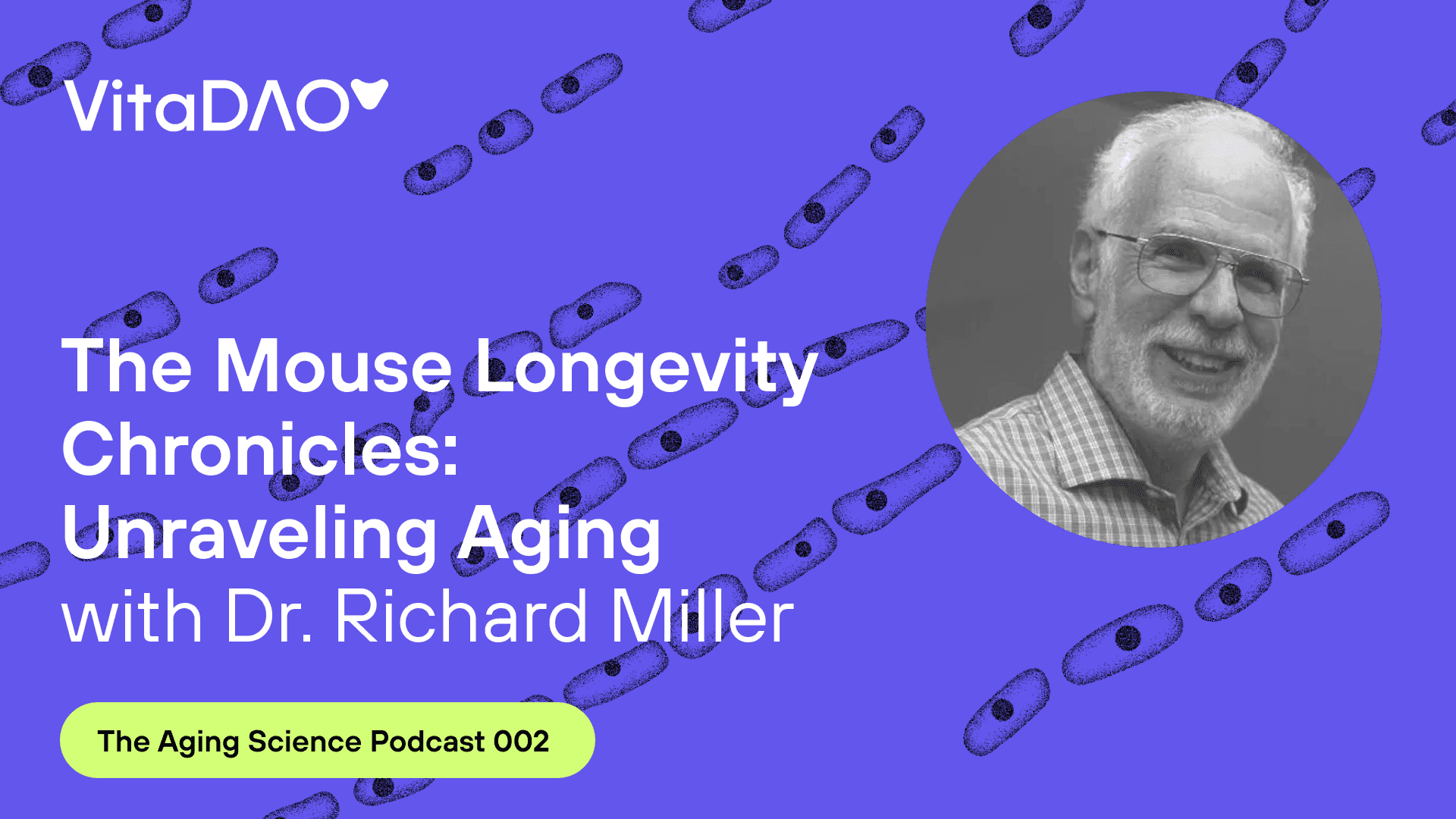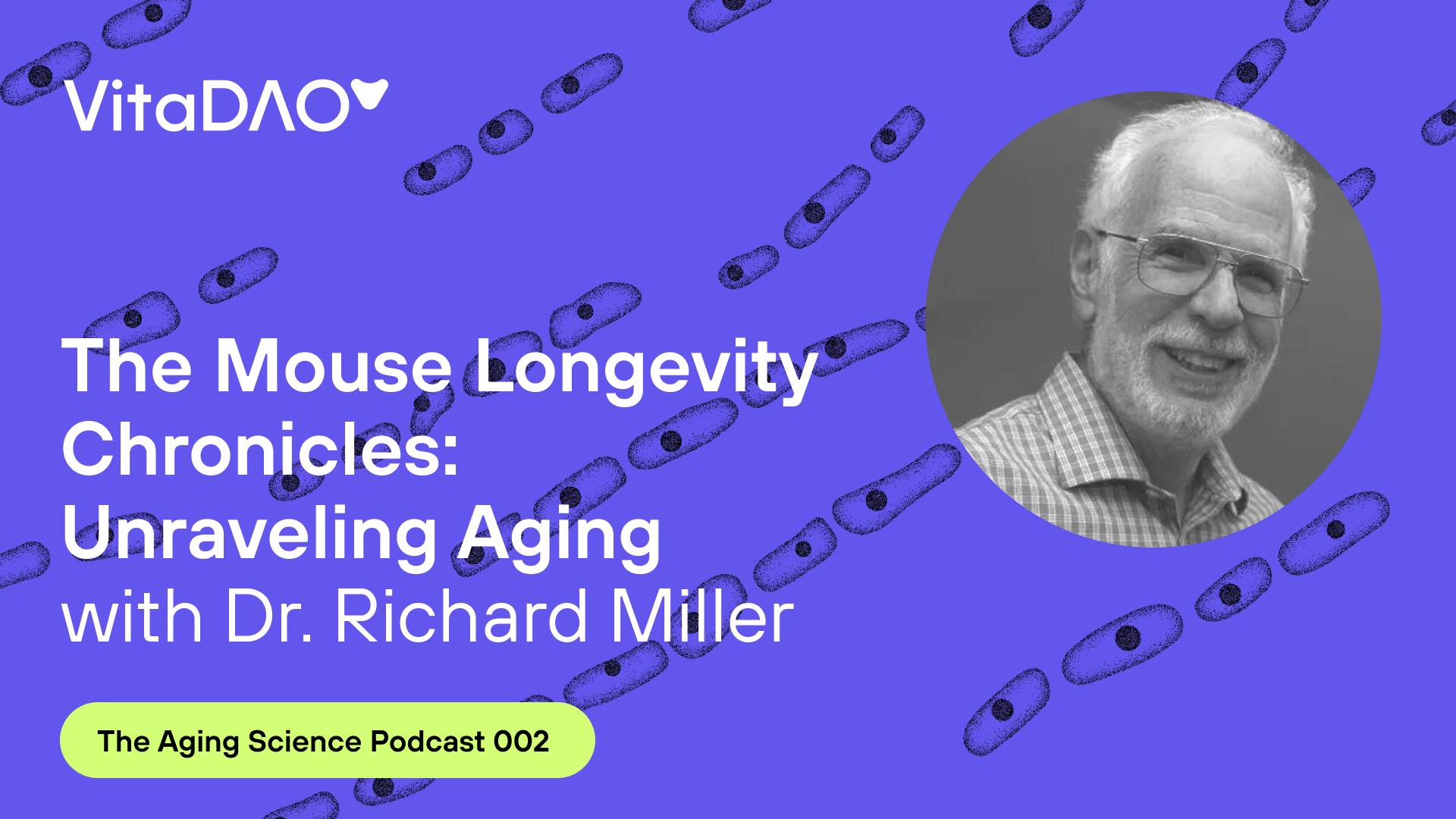
The Mouse Longevity Chronicles: Unraveling Aging with Dr. Richard Miller during The Aging Science podcast by VitaDAO

The Mouse Longevity Chronicles: Unraveling Aging with Dr. Richard Miller during The Aging Science podcast by VitaDAO

Check out the podcast here.
In this podcast, I (@aging_scientist) spoke with Dr. Rich Miller about the ins and outs of mouse aging.
The specific topics we discussed, roughly in this order, included the Interventions Testing Program, rapamycin, mecilizine and other lifespan-extending drugs. We talked about the importance of genetically heterogenous mouse stocks and the issues with fast-aging progeroid mouse models. We also covered his more recent work on aging rate indicators, and the difference between classic biomarkers and aging rate indicators. Finally, we talked about the importance of lifespan research, misuses of the word healthspan and the emerging use of frailty indices in mice.
I did not make it easy for Rich asking some difficult questions, most of which he answered quite well, even if I may disagree here or there. All in all, it was great to interview one of my favorite aging researchers!
About Rich Miller – short biography
Rich Miller got his BA degree at Haverford College, and then an MD and PhD at Yale. He received postdoctoral training at Harvard and Sloan-Kettering and was a faculty member at Boston University before moving to Michigan in 1990.
Now he is a principal investigator at the University of Michigan where his lab studies long lived mice and tries to understand why mice and other animals live as long as they do. He has been instrumental in facilitating the birth of the interventions testing program (ITP) which was the program that first discovered that rapamycin extends the lifespan of mice.
If you want to know one cool piece of trivia about Rich. I once checked and it appears that he has coauthored more mouse longevity studies than a small European country like the Netherlands. This attests to both his experience but also to the lack of mouse research in Europe.
Scientific background
Let us briefly talk about the importance of mouse lifespan studies and why healthy mice are an irreplaceable scientific tool. I will also explain some of the concepts that we discussed in the podcast.
"It's not simple" (Rich Miller)
About the Interventions Testing Program (ITP)
“The Interventions Testing Program (ITP) is a peer-reviewed program designed to identify agents that extend lifespan and healthspan in mice. Investigators at any university, institute, company, or other organization are invited to recommend interventions for testing by submitting an application before the February deadline each year. Testing is carried out in the genetically heterogeneous UM-HET3 mouse stock at three sites — the Jackson Laboratory, the University of Michigan, and the University of Texas Health Science Center at San Antonio.”
Several features of the ITP make it stand out as a very unique project. One is that almost anyone can propose a compound through a simple, short application. Scientists have been calling for simpler grant applications for a while so it is refreshing to see this implemented in practice. Hopefully other institutions will follow suit.
Another feature is the sheer success of the ITP in finding new interventions.
“the ITP has identified nine agents that significantly increase median lifespan — acarbose (Harrison 2014, Strong 2016, Harrison 2019), aspirin (Strong 2008), canagliflozin (Miller 2020), captopril (Strong, 2022), glycine (Miller 2019), nordihydroguaiaretic acid (NDGA) (Strong 2008, Strong 2016), Protandim® (Strong 2016), rapamycin (Harrison 2009, Miller 2011, Wilkinson 2012, Miller 2014) and 17α-estradiol (Harrison 2014, Strong 2016, Harrison 2021).”
Although, all these worked in a subset of mice, I think this list is slightly overstating the success of the ITP. Some of these drugs are much more effective than others. Some of these are in a league of their own. It is hard to compare rapamycin, perhaps the biggest breakthrough of the 21st century (so far), with compounds that produce minor benefits in one gender like e.g. protandim. However, even if the ITP had only discovered rapamycin, it would have been a success in my eyes.
Almost as important as the successes are the failures. The ITP has refuted or weakened the idea that several putative longevity compounds actually slow aging, e.g. metformin and resveratrol. While these could still benefit humans and improve health, the ITP provided strong evidence that they fail to slow aging in mice.
On the importance of good mouse husbandry and healthy mouse strains
"Inbred mice are an inappropriate model for most kinds of aging research" (Rich Miller)
Although in this case Rich was quoting other researchers, I think this does sum up the message he wanted to convey. While I would not go quite that far, I think he is totally right when he says that we need to use healthy, genetically heterogenous mouse models for aging research. As much as possible, whenever feasible.
Humans are diverse and we need diverse models to better represent our biology. Even more importantly, inbred mice often used in research have limited heterogeneity in what they die of. Thus, preventing this one idiosyncratic disease that is killing all mice of an inbred strain could appear to slow aging and extend lifespan when it was just mitigating this one condition. However, in defense of our traditional model the inbred “Black 6” (B6) mouse – and it is indeed a mouse with black fur, hence the name – I would like to note that genetically heterogenous mice still predominantly die from cancer (Lipman et al. 2004) not much different than B6 mice. On top of that, B6 mice are actually quite long-lived for a mouse.
The ITP uses UM-HET3 mice, which are a heterogenous four-way cross, to mitigate the issue of limited genetic diversity. I would like to champion the UM-HET3 mouse as a replacement of B6 and other strains whenever possible. It is a really amazing mouse strain. Please use it in your resarch and when you read a paper featuring UM-HET3 consider this a “bonus point” in favor of that work.
Aging Rate Indicators
The lab of Rich Miller is developing so called aging rate indicators, which could be used to predict how quickly a mouse or a cohort of mice will age. The idea is to find such indicators and to screen a battery of novel compounds against these, before testing them in large, expensive lifespan studies like the ITP.
In the analogy he used the aging rate indicators are a kind of “speedometer”, whereas conventional biomarkers measure the damage that mice accumulated during aging akin to an “odometer”. A mouse that ages at a slower speed will accumulate less damage and hence live longer.
The controversial bits and pieces – progeroid models, frailty and healthspan
Rich is not the biggest fan of senolytics, progeroid models and frailty indices used in mice. We talked about the latter two in the podcast. I think he does a better job explaining this than I could so I will instead just explain the science necessary to understand our podcast.
So called progeroid mouse models show something akin to accelerated aging. They are employed by aging researchers because they die quickly allowing them to test more interventions in a shorter period of time. Whether these models faithfully mimic aging remains a matter of debate in the literature and both sides have good arguments. On the one hand, many of these models develop similar changes to aged mice due to mutations in pathways we think are involved in aging (e.g. DNA repair). On the other hand, most progeroid mouse models develop extreme phenotypic changes that are never seen in aging mice to the same extent.
Frailty indices were developed in order to measure something resembling health, healthspan or frailty in mice – whatever your preferred term is. Basically, functional decline during aging. Indeed, such functional decline almost always precedes mortality and the two are closely linked. However, measuring lifespanis very expensive as it requires many animals. So one of the reasons why mouse frailty indices are gaining popularity is the hope that they could serve as a replacement for expensive lifespan studies. While commonly employed frailty indices do seem to capture functional decline with aging, many parameters included in these indices are not very sensitive to aging (Schultz et al. 2020) and they have not been thoroughly validated across different mouse strains yet. Furthermore, it is also very difficult to observe frailty in mice non-invasively. Old mice often die spontaneously while still looking healthy.
My (minor) disagreements with Rich Miller – ITP compound selection
Asking hard questions is the job of a good journalist and being critical of conventional wisdom is the job of a good scientist. I am trying to be both here.
My major criticism, which Ì tried to explain, was that the ITP is somewhat biased towards approved drugs that target age related diseases, or diseases of affluence, instead of more experimental bona fide anti-aging drugs. As biogerontologists, we always say that we must target the root causes of aging. I do not think that approved most drugs are doing that. Certainly not statins and most blood pressure lowering medications, several of which were tested in the ITP.
As far as I can tell, Rich’ counterargument is that every suggested drug was evaluated on its own merits. Only if the proposal was persuasive then it was accepted. Maybe for some of these traditional drugs arguments can be made why they might slow aging. Indeed, rapamycin itself is an approved drug “traditionally” used for immunosuppression and the proposal certainly included a rationale why it could be repurposed to fight aging based on genetic data from yeast (Kaeberlein et al. 2005).
Furthermore, the proposed rationale and why a drug works do not need to be the same. For example, in the case of acarbose the mechanism of action in mice is subtly different from the one that was proposed, as we discuss in the podcast.
Nevertheless, in my opinion, there remains a bias towards “playing it safe” in the ITP. Just to give an example, I have a really hard time finding a rationale why simvastatin might have slowed aging in mice – because it so specifically targets atherosclerosis, an age-related disease that mice fail to develop. Statins do not work particularly well if you have low blood cholesterol levels and do not reduce all-cause mortality in these populations (Singh et al. 2020), hence the failure in mice was perhaps also predictable.
My (minor) disagreements with Rich Miller – does rapamycin slow or postpone aging?
My second disagreement concerns rapamycin. I think Rich and others are too hastily discounting the idea that rapamycin postpones aging rather than slowing aging, or that something else strange is going on with rapamycin. However, that is not to say that rapamycin would fail to extend lifespan in humans. It may, but the mechanism could be different than we think.
In fact, I believe that rapamycin is the best drug we have right now and I am on the record saying that it should be in the TAME study instead of metformin. No one can claim I am not an optimist about this drug.
I used to think the same way as Rich does: if a drug extends median and maximum lifespan in healthy mice and slows age-related decline then it slows aging per definition.
However, we need to be a bit more precise and distinguish between slowing and postponing aging. In the long term this will be very important.
Different papers studying mortality patterns using Gompertz and other mathematical approaches find that rapamycin behaves differently than caloric restriction and provide evidence for postponing rather than slowing aging (Garratt et al. 2016): “Reduced mTOR signalling extends lifespan in nematodes by strongly reducing the degree to which mortality rates increase with age (aging rate). By contrast, life extension in mice and yeast occurs largely by pushing back the onset of aging, but not altering the shape of the mortality curve once aging starts. Importantly, in mice, the altered pattern of mortality induced by reduced mTOR signalling is different to that induced by dietary restriction, which reduces the rate of aging”
The benefits of rapamycin in the ITP do not scale very well with age of onset. When treatment is started at 600 days of age (20 months), then, expressed as increase in mean lifespan, the effect sizes were +9% for males and +13% for females in the pooled data set (Harrison et al. 2009). For comparison, when treatment was started at 270 days of age or (9 months) then median survival was extended by an average of +10% in males and +18% in females (Miller et al. 2011).
Importantly, one recent paper found that an mTOR hypomorphic allele leads to immediate improvements in multiple age related parameters even in young mice (Xie et al. 2022). This suggests we are measuring age related decline incorrectly without including a young control group. Xie et al. concludes that: “Many [interventions] influence phenotypes long before the onset of detectable age-dependent change, but, importantly, do not alter the rate of phenotypic change. Hence, these [these interventions] have limited effects on aging.”
Hopefully we can revisit this debate some day
Rich Miller in other media
If you still cannot get enough aging science content after having finished our podcast, you can check out the below interviews with Rich.
On Peter Attia’s famous Drive podcast:
https://peterattiamd.com/richardmiller/
On the Live Longer World podcast, which is one of my favorite aging podcasts:
https://www.youtube.com/watch?v=42PzfNs9egA
On the The Sheekey Science Show, which is one my favorite aging channels on youtube:
https://www.youtube.com/watch?v=hHlDTiFWbbg
(you can follow Sheekey on twitter @EleanorSheekey)
On the amazing NUS Healthy Longevity webinar, as published on youtube:
https://www.youtube.com/watch?v=UPqstwgr7x0
(you can register for the webinar here so as not to miss any live sessions: https://medicine.nus.edu.sg/continuing-education/knowledge-hub/healthy-longevity/)
References
Xie, Kan, et al. "Deep phenotyping and lifetime trajectories reveal limited effects of longevity regulators on the aging process in C57BL/6J mice." Nature Communications 13.1 (2022): 1-29.
Harrison, David E., et al. "Rapamycin fed late in life extends lifespan in genetically heterogeneous mice." nature 460.7253 (2009): 392-395.
Miller, Richard A., et al. "Rapamycin, but not resveratrol or simvastatin, extends life span of genetically heterogeneous mice." The Journals of Gerontology: Series A 66.2 (2011): 191-201.
Garratt, Michael, Shinichi Nakagawa, and Mirre JP Simons. "Comparative idiosyncrasies in life extension by reduced mTOR signalling and its distinctiveness from dietary restriction." Aging Cell 15.4 (2016): 737-743.
Singh, Bishnu M., et al. "Role of statins in the primary prevention of atherosclerotic cardiovascular disease and mortality in the population with mean cholesterol in the near-optimal to borderline high range: a systematic review and meta-analysis." Advances in preventive medicine 2020 (2020).
Yourman, Lindsey C., et al. "Evaluation of time to benefit of statins for the primary prevention of cardiovascular events in adults aged 50 to 75 years: a meta-analysis." JAMA internal medicine 181.2 (2021): 179-185.
Schultz, Michael B., et al. "Age and life expectancy clocks based on machine learning analysis of mouse frailty." Nature communications 11.1 (2020): 1-12.
Kaeberlein, Matt, et al. "Regulation of yeast replicative life span by TOR and Sch9 in response to nutrients." Science 310.5751 (2005): 1193-1196.
Lipman, Ruth, et al. "Genetic loci that influence cause of death in a heterogeneous mouse stock." The Journals of Gerontology Series A: Biological Sciences and Medical Sciences 59.10 (2004): B977-B983.


